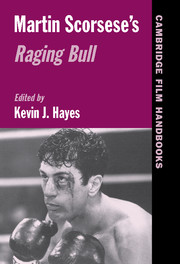Ackroyd, Peter. “All the Rage.” Spectator, 28 February 1981, 26
Barton, Carlin A. “The Scandal of the Arena.” Representations 27 (1989): 1–36
Blake, Richard A. “Redeemed in Blood: The Sacramental Universe of Martin Scorsese.” Journal of Popular Film and Television 24 (1996): 2–9
Boyum, Joy Gould. “A Work of Power and Distinction.” Wall Street Journal, 28 November 1980, 11
Brunette, Peter, ed. Martin Scorsese: Interviews. Jackson: University Press of Mississippi, 1999
Coleman, John. “Box and Cocks.” New Statesman, 20 February 1981, 23
Cook, Pam. “Masculinity in Crisis?: Pam Cook on Tragedy and Identification in Raging Bull.” Screen 23 (1982): 39–46
Dickstein, Morris. “Self-Tormentors.” Partisan Review 64 (1994): 658–664
Friedman, Lawrence S. The Cinema of Martin Scorsese. New York: Continuum, 1998
Girgus, Sam B. America on Film: Modernism, Documentary, and a Changing America. New York: Cambridge University Press, 2002
Grindon, Leger. “Body and Soul: The Structure of Meaning in the Boxing Film Genre.” Cinema Journal 35 (1996): 54–69
Halberstam, Judith. Female Masculinity. Durham: Duke University Press, 1998
Hemmeter, Gail Garnicelli, and Hemmeter, Thomas. “The Word Made Flesh: Language in Raging Bull.” Literature/Film Quarterly 14 (1986): 101–105
Johnson, Carol Siri. “Constructing Machismo in Mean Streets and Raging Bull.” Perspectives on Raging Bull, ed. Steven G. Kellman. New York: G. K. Hall, 1994, 96–106
Kael, Pauline. “Religious Pulp, or The Incredible Hulk.” New Yorker, 8 December 1980, 217–225
Kellman, Steven G., ed. Perspectives on Raging Bull. New York: G. K. Hall, 1994
Keyser, Lester J. Martin Scorsese. New York: Twayne, 1992
La Motta, Jake, Joseph Carter, and Peter Savage. Raging Bull. 1970. Reprinted. New York: Bantam, 1980
Leed, Barry H. “Scorsese vs. Mailer: Boxing as Redemption in Raging Bull and An American Dream.” Perspectives on Raging Bull, ed. Steven G. Kellman. New York: G. K. Hall, 1994, 131–135
Librach, Ronald S. “The Last Temptation in Mean Streets and Raging Bull.” Literature/Film Quarterly 20 (1992): 14–24
Malcolm, Derek. “The Punch in Scorsese's Ring Cycle.” Guardian, 14 February 1981, 10
Mortimer, Barbara. “Portraits of the Postmodern Person in Taxi Driver, Raging Bull, and The King of Comedy.” Journal of Film and Video 49 (1997): 28–38
Nicholls, Mark. “Something For the Man Who Has Everything: Melancholia and the Films of Martin Scorsese.” Playing the Man: New Approaches to Masculinity, eds. Dave Trudinger, Katherine Biber, and Tom Sear. Annandale, Australia: Pluto Press, 1999, 39–51, 215–216
Nicholls, Mark. Scorsese's Men: Melancholia and the Mob. Annandale, Australia: Pluto Press, 2004
O'Toole, Lawrence. “Going the Distance, and Much, Much Farther.” Maclean's, 1 December 1980, p. 73
Ringel, Eleanor. “Raging Bull Goes the Distance in Spite of Itself.” Atlanta Constitution, 20 February 1981, 3B
Thompson, David, and Ian Christie, eds. Scorsese on Scorsese. London: Faber and Faber, 1989
Tomasulo, Frank P. “Raging Bully: Postmodern Violence and Masculinity in Raging Bull.” Mythologies of Violence in Postmodern Media, ed. Christopher Sharrett. Detroit: Wayne State University Press, 1999, 175–197
Westerbeck, Colin L., Jr. “Shadowboxing: A Fighter's Stance toward Life.” Commonweal, 16 January 1981, pp. 20–21
Weiss, Marion W. “Linguistic Coding in the Films of Martin Scorsese.” Semiotica 55 (1985): 185–194



